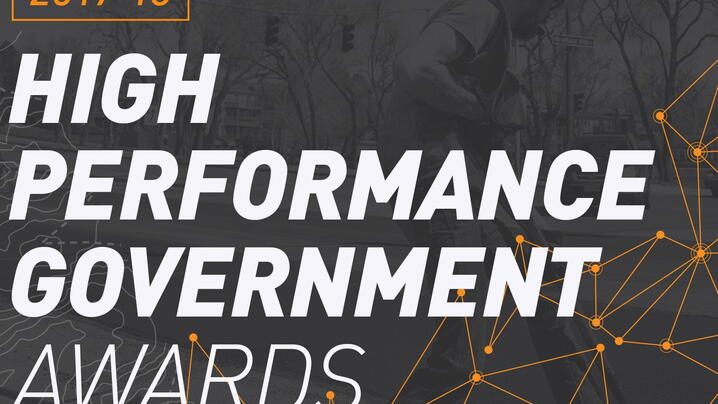
by Nick Kittle, government performance and innovation coach, and high-performance government awards judge, Cartegraph
Each day, local government employees—just like you—are striving to become more effective, more efficient, and more productive for residents. They work tirelessly to find new ways to solve problems, spend smarter, measure performance, and improve their communities.
Here at Cartegraph, we think that’s something to recognize and celebrate. Which is why I’m thrilled to highlight the winners of our 2017–2018 High-Performance Government Awards. These seven communities rose to the top of the competition based on their accomplishments using operations management software in several core areas, including infrastructure management and improvement, operational efficiency, resident engagement, and data-driven decision making.
This list represents some of the best work being done in the country today, and we’re so proud to work with these forward-thinking organizations:
City of Arlington, Texas
With more than 90 parks, estimating maintenance costs was a cumbersome and expensive process for the city. Manually inspecting the park system took more than 4,500 labor hours to complete, and the paper-to-database approach was redundant and expensive. Putting mobile inspection capabilities and built-in overall condition indexes to work, the Arlington team is now assessing and analyzing its infrastructure in real time, saving 4,100 hours or $62,000 in labor costs annually.
City of Auburn, Washington
Auburn dared to overcome a common dilemma: how do you pinpoint the location of an asset you can’t see? To prevent the expensive repairs and major project delays that come with unintentionally digging up critical assets, the city combined Cartegraph technology, ArcGIS, and 3D mixed reality to arm crews with “x-ray vision.” Now, whether they’re in the field or in the office, staff can see and interact with underground assets without ever lifting a shovel. This futuristic tech has even opened the door to more dynamic council presentations and easier remote or confined-space inspections.
Town of Bluffton, South Carolina
Implementing software is a challenge for any organization, but “going live” during a disaster certainly ups the ante. Hours before Hurricane Irma fell upon Bluffton; crews hit the ground running, inventorying equipment, programming FEMA rates, and learning to create tasks, enter labor hours, and more from mobile devices. Rallied together, crews logged 200 hours of cleanup work, and real-time FEMA reimbursement reporting helped save three days—or $5,000—in post-storm data entry labor costs.
Village of Buffalo Grove, Illinois
With more than 13,000 annual vehicle inspections, the Buffalo Grove public works team sought to streamline its paper-based fleet reporting and repair workflows. Combining mobile inspections and automated workflows, crews are now reporting on daily vehicle conditions and generating fleet repair tasks in real time. What seems like a simple solution has Buffalo Grove reaping hefty rewards, saving the village 13,145 sheets of paper or nearly two trees, 35 days, and some $20,000 in labor hours every year.
City of Kingsport, Tennessee
To facilitate water compliance, documentation is key. But when crews are fixing an emergency main break in freezing temperatures, it’s easy to forget to record a step. After building automated maintenance workflows, the Kingsport team is confident they’ll never miss a beat. During de-watered repairs, crews are now required to fill in chlorine and bacteriological sample fields before moving on, and follow-up flushing tasks are automatically created based off the readings. To date, Kingsport has saved 32 hours in documentation review and followup and can prove—without a doubt—they’re delivering safe, clean water to residents.
City of New Braunfels, Texas
As the second fastest growing city in the nation, New Braunfels is challenged with providing residents with the best service possible—especially when it comes to its pavement management program. By leveraging real-time street maintenance data, the team is confidently allocating limited resources and has even justified a 50 percent budget increase. Through streamlined reporting, the city is saving hours on spreadsheet entry, responding to resident requests twice as fast, and increasing transparency with both residents and other departments.
City of Pittsburgh, Pennsylvania
When an infrastructure network is built for twice your current population, you need to make educated decisions on how time and taxpayer dollars are spent. That’s why Pittsburgh is using its work and asset data to build equitable street paving budgets based on practical—not political—infrastructure improvements. The staff has become more compelling, data-driven storytellers, resulting in a $1 million paving budget increase, more informed city planners, safer streets, and improved transparency and resident engagement.
About Cartegraph:
Cartegraph, headquartered in Dubuque, Iowa, is an ICMA Strategic Partner. The company empowers cities and counties to become high-performance organizations by offering services and software to help local government agencies manage assets effectively, deploy resources efficiently, and become more productive for the benefit of residents. For more information, visit www.cartegraph.com.
Related Content
5 Principles for Successful High-Performing Local Government. This 2016 blog post looks at case studies in which good leadership had led to communities becoming high performing regardless of their size.
A Recipe for Success. This 2018 PM article looks at seven factors that lead to high performance.
In Search of Organizational Excellence? In a 2016 article, the focus was on how to achieve organizational excellence. Topics covered included strategic planning and the importance of organizational values.
New, Reduced Membership Dues
A new, reduced dues rate is available for CAOs/ACAOs, along with additional discounts for those in smaller communities, has been implemented. Learn more and be sure to join or renew today!
